English summary
1. Profile of the Company:
• Full name: Pouyandegan Mohit Zist (Environmental Engineering Consultant, Private Joint Stock Company)
• Registration No. 291087 & National ID No. 10103289637
• Central office address: No. 1103, Valieasr st., before Jomhouri st., Tehran, Iran
• Tel No: +982166475315, +982166466733, +982166466682
• Fax No: +982166480419
• Website: www.pmz.ir
• Name of Director Manager and Chair of Board of Directors: Dr. Borhan Riazi
– Summary of Goals and Mission:
Pouyandegan Mohit Zist Co. (LTD), aimed at evaluation and monitoring of organizational performance indicators conducting environmental research, founded by a multitude of professors and experts. Thanks to the founders’ expertise, the planning and budget organization issued valid certificate for consulting services No. 352932 dated 05/07/1399, approving the company for the most qualified consultation services. The company is amongst a few companies providing consulting services particularly on “environment”.
2. Some licensees and documents:
– Certificate of qualification for consultation services (Fig.1)
– Notice of Changes Made to Pouyandegan Mohit Zist Co. (privately held) (Fig.2)
– Membership license in Iranian society of consulting engineers (Fig.3)
– Quality management license for 2015 year, ISO 9001 (Fig.4)
3. Scope of the Company:
Based on Article 2nd of the company’s association, the scope of the company’s activities are as follows (Fig.5):
– Conducting consulting services, studies, research, and inspection and monitoring in the environment, water, natural resources, and pedology related field. In addition, the activities entailing surveying, environmental impact assessment, wild animals, vegetation, and water shed management, flood control, surface water, wastewater management, spatial planning, coastal control, computer services, database establishment, along with mutual collaboration with both foreign and domestic companies, observing the environmental laws and regulations.
4. Organizational Chart and Workflow Diagram
The company’s organizational chart is illustrated in figure 6: primary studies is assigned for inspection deputy and basic studies environmental impact assessment is allocated to the deputy of impact assessment through expert groups. The second figure shows primary process workflow, providing study services before and after the contract.
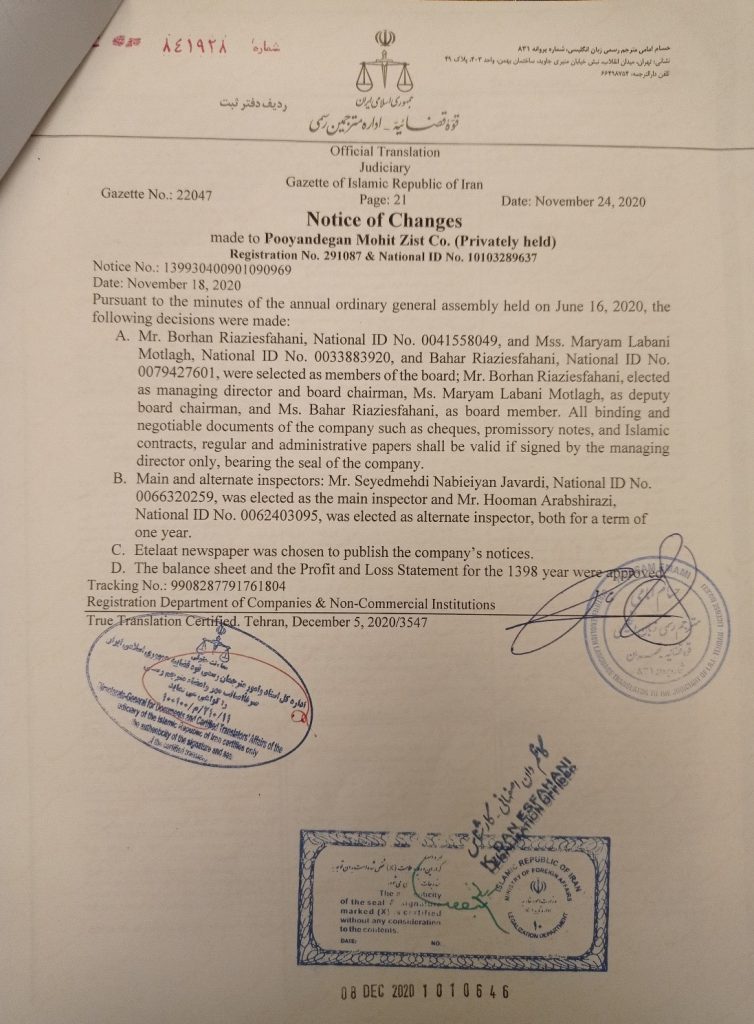
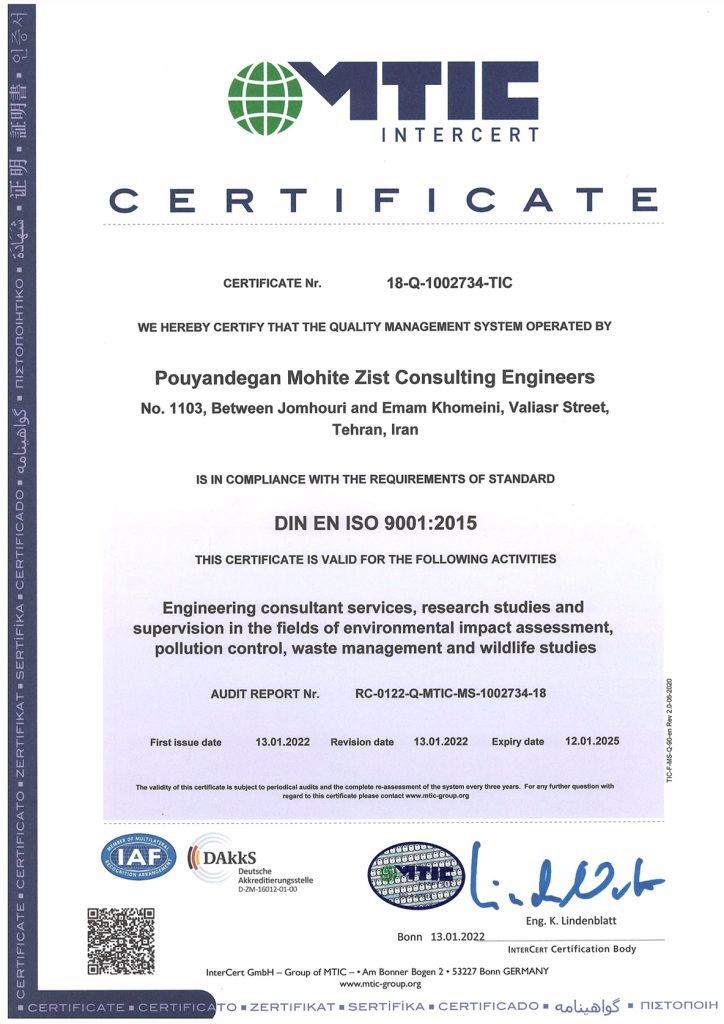
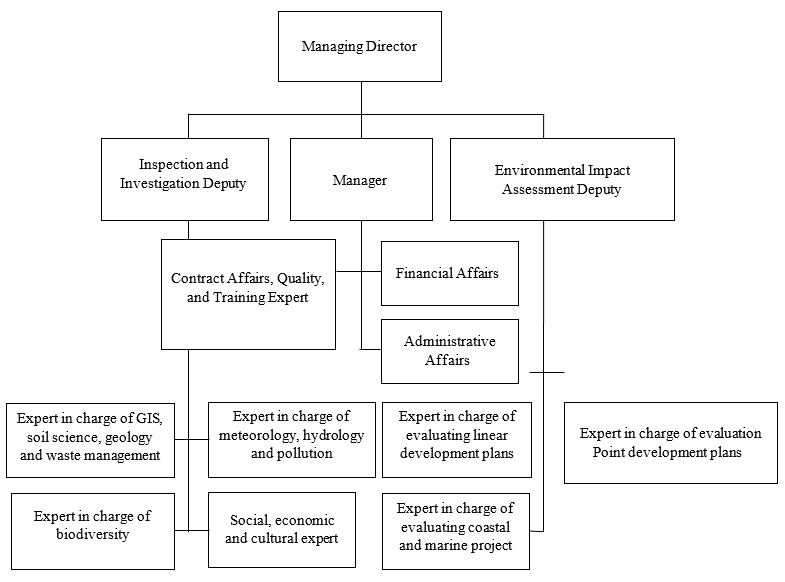
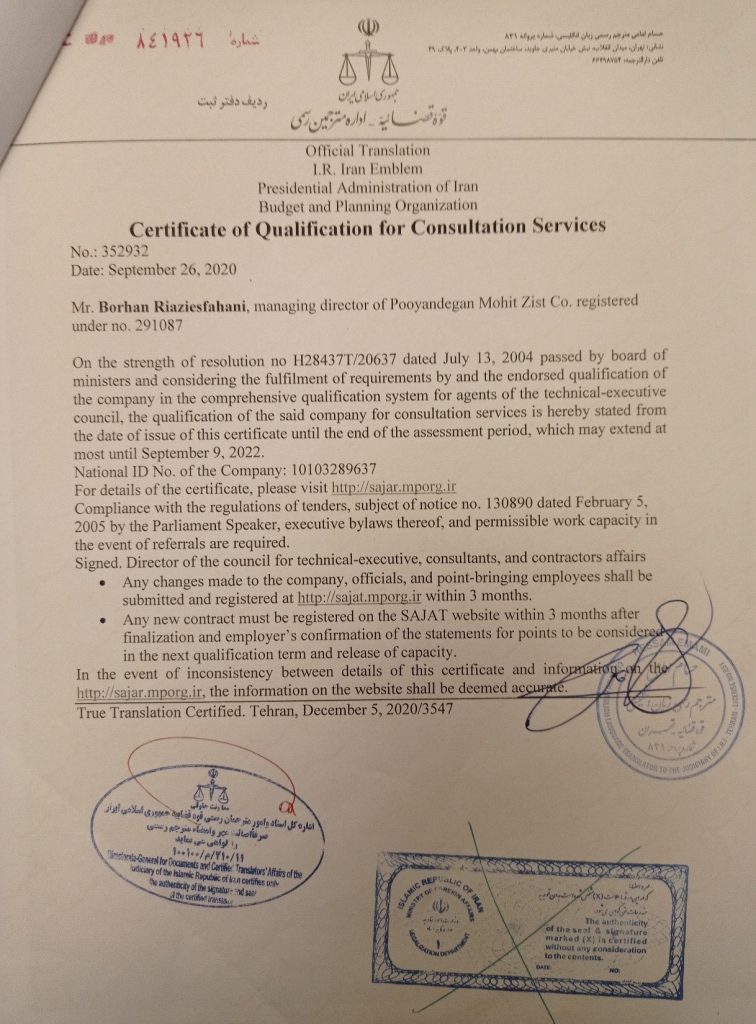
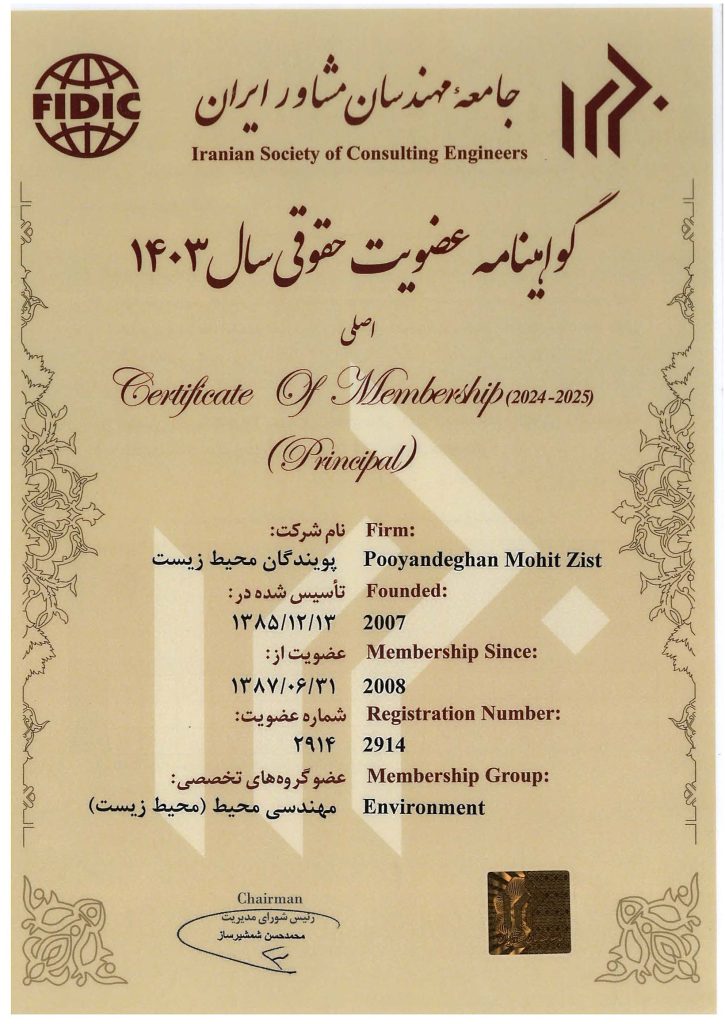
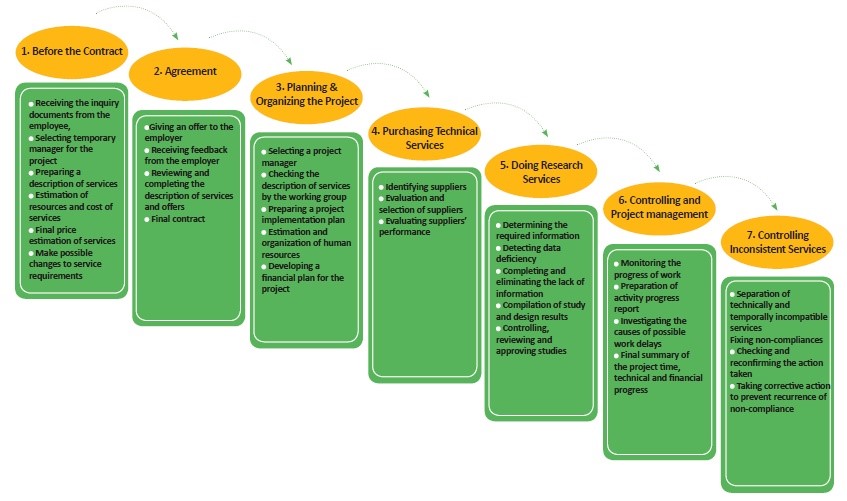
5-Resume of Dr. Borhan Riazi (Director Manager of the Company):
E-mail: 
5.1. Educational and professional qualifications:
1. PhD in Environmental Management (1380),
2. Master in Environmental Studies (1364),
3. Bachelor in Natural Resources Engineering (1349),
4. Certificate of participation in International Green Productivity and Ecotourism Course (September 2001, Japan),
5. Certificate of Participation in International Wetland Management Course (May 22- Jun 22, 1997, Netherlands),
6. International Certificate in Parks and Protected Areas (August 6 to September 6, 1975, University of Michigan and USA Park Service)
7. The Forest and Timber Industry Course (December 1970 to August 1971, Yugoslavia)
With 30 years of expertise and management experience in the Environmental Protection Organization, he has been retired since November 2001. Since October 1993, he has been a part-time official faculty member at the Islamic Azad University (working in the Graduate School of “Environment”, Science and Research Branch). He is the CEO and Chairman of the Board of Directors of “Pouyandegan Environmental Consulting Engineers Company” (approved by the Planning and Budget Organization). He is the chairperson of the founding board of the Pouyandegan Sabz Environmental Management Research Group (licensed by the Higher Education Development Council).
5.2. English Language Articels:
1. Abedi, Z; N. Moharram Nejad, Borhan Riazi and Maryam Bayat. Winter 2012. Investigation of cost damages on plants by laky sazbon dam. Environmental Science and Technology, Volume 13, Number 4 (51), Page(s) 67 to 80.
2. Ansari, A; M. karami, H.R. Rezai and Borhan Riazi. 2015. Effects of Habitat Fragmentation on the Genetic Structure of Populations of Wild Goat, Capra aegagrus Erxleben, 1777 (Artiodactyla: Bovidae) in Markazi Province, Central Iran. Acta zoological bulgarica. Number 67, Page(s) 501 to 506.
3. Ashoori, A; Borhan Riazi et alls. June 2009. Breeding Biology of Grey Heron (Ardea cinerea) in Siahkeshim Protected Area, Northern Iran. (ISI) Journal of Podoces, Number 4(1), Page(s) 37-43.
4. Babazade Khameneh, S; A. danekar, F. Taheri and Borhan Riazi. 2015. Management planning of demanding outdoor recreational activities in Sisangan forest Park (Iran). Environmental Engineering and Managemet Journal, “Gheorghe Asachi” Technical University of lasi, Romania.
5. Babazadeh Khameneh, S; A. Danekar, F. Taheri and Borhan Riazi. October 2014. Management planning of demanding outdoor recreational activities in sisangan forest park (IRAN). Environmental Engineering and Management Journal.
6. Babazadeh, S. and Borhan Riazi. 2016 .Demographic analysis of the visitors of Sisangan forest prak. Nat Sci, N 14(4), P 102-10, ISSN 1545-0740 (print), ISSN 2375-7167 (online).
7. Bali, A; S.M. Monavari, Borhan Riazi et alls. June 2015. A Spatial Decision support system for ecotourism development in Caspian Hyrcanian Mixed Forests ecoregion. Boletim de ciencias geodesicas, Page(s) 340 to 353.
8. Banagar, G; B. Riazi, H. Rahmani and M. Naderi. 2018. Monitoring and assessment of water quality in the Haraz River, using benthic macroin vertebrates indices. Institute of Zoology, Slovak Academy of Sciences.
9. Cheraghi, M; N. Khorasani, M. Karami, M. Shariat, Borhan Riazi. 2008. The Conformity of Iran’s Protected Areas with IUCN Categorization System. (ISI) Journal of Biological Science, 8 (2), 441-445.
10. Dabiry, F and Borhan Riazi. Fall 2010. The study of some legal challenges of four regions under the management of environment department in Guilan province. Sciences and Techniques in Natural Resources, Volume 5, Number 3, Page(s) 101 to 114.
11. Dashti, S; S.M. Monavari, S.M. Hosseini, Borhan Riazi and Mansoor Momnie. 2013. Application of GIS, AHP, Fuzzy and WLC in Island Ecotourism Development (Case study of Qeshm Island, Iran). Life Sciences Journal, ISSN:1097-8135, N 10(1):1274-1282.
12. Dashti, S; S.M. Monavari , S.M. Hosseini , Borhan Riazi and Mansoor Momeni. Fall 2012. land use planning model for tourism development in the Persian Gulf Islands (case study of Geshm Island). Wetland Ecobiology , Volume 4 , Number 13, Page(s) 49 to 61.
13. Deheshvar, T; A. Danehkar, M. Monavari, B. Riazi and M. Kheirkhah. 2016. Mapping of multi-stresses in a coastline for coastal management. Asia Life Science 25(1). pp 43-62.
14. Esfandabad, Bahman Shams; M. Karami, M.R. Hemami, Borhan Riazi and Mohammad Bagher Sadough . December 2010. Habitat associations of wild goat in central Iran: implications for conservation (ISI). European Journal of Wildlife Research, Page(s) 883 to 894.
15. Eskandari, M; Borhan Riazi et alls. 2012. A study of threatened species of ferns in Gilan province (Iran) providing a comparison of protective classification of conservation based on iucn’s factors. Rostaniha, Volume 13, Number 1 (42), Page(s) 1 to 9.
16. Esmaeil Ramaji, M; Borhan Riazi et alls. Winter 2011. The study of species diversity of woody plants in khoshkedaran national natural monument. Sciences and Techniques in Natural Resources, Volume 5, Number 4, Page(s) 63 to 74.
17. Ghafaripour, S; M. Naderi, B. Riazi and H.R. Rezaei. 2018. How Prey Density and Distribution can affect Predator Habitat usage Pattern: a case study on Sand Cat (Felis margarita) form Iran. Russian Journal of Ecology, Vol. 49, No. 4, pp 310-314.
18. Habibzadeh, N; M. Karami, K. Alavipanah and Borhan Riazi. 2013. Landscape Requirement of Caucasian black grouse (Tetrao mlocosiewiczi) in Arasbaran region, East Azerbijan province, Iran. The Wilson journal of ornithology (ISI), 125 (1), Page(s) 140-149.
19. Habibzadeh, N; M. Karami, S.k. Alavipanah and Borhan Riazi. 2012. Landscape Requirements of Caucasian Grouse (Lyrurus mlokosiewiczi) in Arasbaran Region, East Azarbaijan. Iran.
20. Heshmati, I; N. khorasani, B. Shams Esfandabad, B. Riazi. December 2018. Forthcoming risk of Prosopis juliflora global invasion triggered by climate change: implications for environmental monitoring and risk assessment. Environ Monit Assess, 191:72.
21. Kalani, N and Borhan Riazi. May 2015. Contamination and Toxicity of Heavy Metals (As, Cd, Cr, Pb And Ni) In Leaping Mullet Species. Allgemeine Forst und Jagdzeitung, Vol 14.
22. Karimi, H; Borhan Riazi and M. Mohammadi. 2019, April 2-4. Application of Computational Fluid Dynamics in the Simulation of Carbon Monoxide Distribution, a Case Study: Sayad Underground Tunnel in Tehran. Recent Researches in Earth and Environmental Sciences, springer Proceedings in Earth and Environmental Sciences, pp 1-7.
23. Kalani, N; Borhan Riazi et alls. Spring 2014. Heavy metal concentrations in liza saliens muscle and human health risk estimates from fish consumption in Gomishan international wetland, Iran. Aquatic animals & fisheries,Volume 5, Number 17, Page(s) 65 to 79.
24. Karami, M; Borhan Riazi and N. Kalani. Summer 2008. Seasonal distribution of striped Hyaena (Hyaena hyaena hyaena) in Khogir National Park, Iran. Environmental Science and Technology, Volume 10, Number 2 (37), Page(s) 100 to 105.
25. Karami, M; Borhan Riazi and N. kalani. Spring 2006. Habitat evaluation of the striped Hyena (Hyaena hyaena hyaena) in Khojir National Park. Environmental Sciences, Volume 3, Number 11, Page(s) 77 to 86.
26. Karami, M; Borhan Riazi et alls. Fall 2009. The public perception of stripped hyaena (hyaena hyaena hyaena) in Khojir national park. Environmental Science and Technology, Volume 11, Number 3 (42), Page(s) 281to 294.
27. Karami, M; Borhan Riazi et alls. Winter 2006. The study of mesopotamian soft-shell turtle (rafetus euphraticus) and its habitat in Iran. Environmental Science and Technology, Number 27, Page(s) 74 to 85.
28. Khorami Pour, S; S.M. Monavari, Borhan Riazi and Nematollah Khorasani. 2015. Caspian rapid assessment method: a localized procedure for assessment of wetlands at southern fringe of the Caspian Sea. Environmental Monitoring and Assessment.
29. Moharam nejad, N; A. Zamanipoor, E. Kahrom, Borhan Riazi and Gh. Hadarbadi. 2012. Comparsion of the Effects of Formal Education on the Rangeland Health (case study: Hosseinabad Plain of Sarbisheh, Southern Khorasan Province, Iran). Archive Des Siences, Vol 65, N 7, P 577-592.
30. Moharram nejad, N; A. Zamanipoor, E. Kahrom, Borhan Riazi and Gh. Hadarbadi. May 2012. Coparison of the Effect of two Socio- economic Factors (HDI and HPI) on the Rangeland Health in Desert Region. Texas Journal of Science (TJS- ISI), N 23(5), P 196-207.
31. Naderi, G; M.R. Hemami, Borhan Riazi Aliasghar Alesheikh. 2010. Habitat use of Iranian jerboa (ALLactega firouzi womochel 1978). Ekologia (Bratislava) journal, Number 29 (4), Page(s) 460-463.
32. Naderi, Gh; Borhan Riazi et alls. 2013. Habitat preferences of Bezoar wild goats (Capra aegagrus) in Agh- Dagh protected area, Iran. North-Western Journal of Zoology, N 9 (1), P 99-102.
33. Naderi, Gh; M.r. Hemami, Borhan Riazi et alls. 2009. Notes on the ecological peculiarities of the Iranian Jerboa (Allactaga firouzi). ISI Journal of Zoology in the Middle East, No 47, Page(s) 21-28.
34. Naderi. G; M.R. Hemami, S. Mohammadi, Borhan Riazi. 2011. Effects of vegetation and soil conditions on burrow structure and site selection of Iranian jerboa (Allactaga firouzi). Polish Journal of Ecology (ISI), Vol 59, N 2, Page(s) 403-411.
35. Nouri, J; R. Arjmandi, Borhan Riazi et alls. January 2016. Comparing MCDM and HUFF model to determine the most appropriate method for selecting mountain tourism sites. Environmental Engineering and Management Journal (EEMJ), Vol 15 Issue 1, p 41-52.
36. Nowzari, H; M.R. Hemami, M. Karami, M.M. Kheirkhah Zarkesh, Borhan Riazi and Daniel Rubenstein. Rubenstein. 2013. Habitat use by the Persian onager, Equus hemionus onager (Perissodactyla: Equidae) in Qatrouyeh National Park, Fars, Iran (ISI). Natural History, Taylor & Francis, Vol 47, NO 43-44, Page(s) 2495-2814.
37. Qazalifar, N; N. Jafarzadeh Haqiqi fard, Borhan Riazi and Esmaeil Kahrom. 2011. Ecological Evaluation of Bamdezh Wetland of Izel Using Canadian Calibrated Model. International congress of environmental research. India, JERAD & SVNIT.
38. Reyahi khoram, M; Borhan Riazi and Vahid Norisharikabad. Fall 2010. Study of the nests of (sterna nilotica) in ag-gol wetland of hamedan province. Wetland Ecobiology, Volume 2, Number 5, Page(s) 37 to 42
39. Riazi Borhan et alls. 2015. Urban Land Planning and Change Detection Using Satellite Images (case study: Anzali Wetland Watershed). Vol 5, PP 3346-3351.
40. Riazi, Borhan and Mahmoud Nouri Mashiran. 2 February, 2017. Isfahan province drought analysis by using standardized precipitation index (SPI) in the time scale of long-term. Ecology, Environment and Conservation, Page(s) 601 To 608.
41. Riazi, Borhan et alls. 2009. Pattern of habitat use and niche partitioning between wild goat and wild Sheep in Central Iran. (ISI) Journal of Natural History.
42. Riazi, Borhan et alls. 2015. Urban land planning and change detection using satellite images (Case study: Anzali wetland watershed). Indian Journal of Fundamental and Applied Life Sciences, ISSN:2231-6345 (Online), Vol 5 (S1), Page(s) 3346-3351.
43. Riazi, Borhan et alls. Fall 2006. The effect of road and railway transportation on wildlife. Environmental Science and Technology, volume 8, Number 3 (30), Page(s) 53 to 60.
44. Riazi, Borhan et alls. Winter 2002 .Ecological study of waterfowls in Gomishan wetland. Environmental Science and Technology, Number 11, Page(s) 83 to 103.
45. Riazi, Borhan et alls. Winter 2008. Biometric relations of hawksbill turtle in Geshm Island’s coasts. Environmental Science and Technology, Volume 9, Number 4 (35), Page(s) 139 to 148.
46. Riazi, Borhan. 1997. Management Plan of Anzali Wetland. International course on Wetland Management, The Netherlands.
47. Riazi, Borhan. 2000. Botanical Gardens in Iran. Encyclopaedia Iranica, Columbia University, New York, Volume 10. Page(s) 308-310.
48. Riazi, Borhan; A. Mirarmandhi. September 2008. Study on the wintering water birds of Guilan, Mazandaran and Golestan, and ranking the wetland areas based on the bird criteria. Environmental Studies, Volume 34, Number 46, Page(s) 89 to 100.
49. Sabzghabaei, Gh; S.M. Monavari, Borhan Riazi et alls. Winter 2013. Analyzing corporation of pressures and threats of tropical wetlands by using rappam method (case study: khuzestan province wetlands). Wetland Ecobiology, Volume 4, Number 14, Page(s) 55 to 68.
50. Sabzghabai, Gh.R; S.M. Monavari and Borhan Riazi. 2015. Analysing Pressures and threats on the southern Wetlands of Iran with the application of RAPPAM methodology (case study: Khuzestan Province). )Globa) Nest Journal, Vol 17, No 2, Page(s) 344-356.
51. Salman Mahini, A; A. Nadali, J. Feghhi and Borhan Riazi. Spring 2012. Tree cover detection through maxlike classification of landsat Etm + images of the year 2001 in Golestan province. Environmental Science and Technology, Volume 14, Number 1 (52), Page(s) 97 to 106.
52. Salman Mahini, A; J. Feghhi, A. Nadali and Borhan Riazi. Fall 2008. Tree cover change detection through artificial neural network classification using landsat tm and Etm+ Images (case study: Golestan province, Iran). Iranian Forest and Poplar Research, Volume 16, Number 3(33), Page(s) 495 to 505.
53. Taati, B; M. Kaboli and Borhan Riazi. Winter 2013. Spatial niche segregation between waterfowls at selkeh wildlife refuge. Wetland Ecobiology, Volume 4, Number 14, Page(s) 83 to 92.
54. Taraz, F; Borhan Riazi and Ali Jozi. 2014. Strategic environmental assessment for development of rail transport network in the north of Iran. International journal of current life science, ISSN:2249-1465.
55. Tashakor, Sh; M.R. Hemami, Borhan Riazi and Reza Jafari. Spring 2013. Impacts of green space parameters on bird species richness of city parks: case study of Isfahan city. Environmental Science and Technology, Volume 15, Number 1 (56), Page(s) 137 to 149.
56. Teimoory, H; M.Z.H. Abadi, G. Amin, Borhan Riazi et alls. 2014. Ecology, Agrotechnics and Soil Science Investigation on Biodiversity from Volatiles Poit Of View of Artemisia Sieberi. Bulgarian Journal of Agricultural Science, Volume 20, Number 6.
57. Teimouri, H; G. Amin and Borhan Riazi. 2014. Investigation on Biodiversity from volatiles point of view of Artemisia sieberi. Bulgarian journal of Agricultural Science, Volume 20, No 6.
5.3. Other items:
– CEO of Environmental Consulting Engineers (certified in environmental expertise)
– Chairman of the founding board of the Green Pooyandegan Environmental Management Research Group (Granting license from the Higher Education Development Council)
– Possessing official license as environmental experts, issued by the Association of Official Experts of Justice
– Supervisoring more than 100 academic dissertations in various fields of environment
– Being adviser to more than 100 academic dissertations in various fields of environment
– Delivering lecture in more than 50 seminars and conferences, both domestic and foreign, in the field of environment
– Executor of several plans and projects in the Environmental Protection Organization, until 2001
– Member of the National Committee for Sustainable Development, Chairman of the Subcommittee on Biodiversity (based in the Environmental Protection Organization), from 1996 to 1998
– Member of the Strategic Committee of “Development of National Strategy and Action Plan for Biodiversity of the Islamic Republic of Iran” (based in the Environmental Protection Organization) from 1998 to 2000
– Member of the “Especial Expert Committee” of the Ministry of Energy to review major development projects of the country’s water affairs, (notification No. 130/890 dated 22/01/1378 Deputy Minister of Energy for Water Affairs) until 2004
– Member of the editorial board of the scientific journal of the Environmental Protection Organization. From 1375 to 1383
– Member of the Editorial Board of the Scientific Quarterly of Environmental Management from 2011 to 2015
– Member of the monthly scientific editorial board of Sonboleh from 2002 to 2011
– Member of the Editorial Board of Kouhestan journal from 2005 to 2011
– Head of the Environment Committee, in the Iranian forestry community. From 1385 to 1392.
6.Quality control, guarantee system and education:
continuous improvement of the quality of study activities due to satisfied employers are the most important pillars of the quality control system in the consulting engineers.
6.1. Quality policy:
Poyandegan Environmental Consulting Engineers Company by providing consulting, studies, research and monitoring and inspection services in areas related to the environment such as environmental impact assessment projects, pollution elimination, waste management and studies. Animal wildlife always aims to improve the quality of services and continuous improvement of quality management. In order to fulfill this matter and the obligations between the company and the employers, the officials and employees of their company are obliged to observe the following principles:
– Attributing aattention to the principle of customer orientation and efforts to increase employer satisfaction
– Continuous improvement of service quality and submission of reports in accordance with scientific and technical standards and requirements
– Raising the level of technical awareness of personnel through training and development of quality culture in the organization
– Increasing employee participation in achieving the goals of the organization by creating a motivational system
– Improving the financial performance of the organization by increasing competitiveness and development of activities, while continuously improving the quality of services
6.2. Certification of quality management systems based on ISO 9001: 2015 standard:
Since the establishment of the company, improving the quantity and quality of services provided has been considered. Achieving systematic goals, the quality management system of ISO 9001: 2015 has been established in these consulting engineers by using the services of a competent consultant.
6.3. Project control system:
Control of projects in environmental scanners includes activities such as comparing planned processes with implemented processes, matching project progress with approved time schedules, summarizing the overall status of project time and cost progress in specific periods, identifying strengths and Project weakness and performance improvement and possible corrective action.
6.4. Documentation system
The purpose of documentation is to prepare a set of documents that show the development and realization of each project from start to end along with analysis and evaluation. The company manages, maintains and retrieves its information and documents in the following ways:
– Storing digital project information in the form of software files
– Storing calculations and computer models data on CD and backup hard drive
– Storing reports, documents, records and other correspondence in the company’s documentation center (archive)
– Using the website and activating a specific field to transfer and update the information of each project
– Preparing and presenting POWER POINT summary of relevant reports for meetings
– Recording discrepancies, initiatives and creativity from the beginning to the end of each project.
6-2- Education
At Pouyandegan Environmental Consulting Engineers, all employees must be familiar with the technical and professional skills defined in their job descriptions and responsibilities. These skills are always evaluated and improved. To achieve this goal, “Environmental Scanners” has determined a systematic strategy to assess and identify the training needs and improve the scientific level of employees and ultimately raise the quality level of services. For this purpose, the educational background and needs of the employees are continuously reviewed. According to the available facilities, educational priorities are determined. Exchange of scientific experiences between people during studies, use of books, pamphlets and scientific software, use of virtual environments, computer science communication and participation in training courses are some of the methods used in this field.
7. Softwares
The company can analyze and process various types of environmental data by using various environmental software (according to Table 2). Some of these are described below:
SDSM Uses static SDSM software in connection with climate change studies.
Due to the need for hydrological and hydrogeological modeling to predict the environmental effects of projects, a set of software, especially HEC, GSM, MIKE, and GIS are used.
Uses software such as Aermod, Flaresim, and Tank for modeling related to air pollution.
other software used: related to soil pollution (VS2DI), environmental risks (Aloha, Phast), waste management and engineering (IWEM), statistical analysis (SPSS), noise pollution (Custic), water resources management ( Venism), River and Reservoir Engineering (CE-qual-W2 and Mikell),
Hydrodynamic modeling of the sea and waves (3 and Mike21) and software related to health assessment studies (HARP).
Table 2. List of available softwares:
| Version | Description | Software Name | Item |
|---|---|---|---|
| 5.2 | Climate Change projection modelling | SDSM | 1 |
| 2016.2.0 | Climate Change projection modelling | PRECIS | 2 |
| – | Hydrology | HEC family:(Hec-MS,HEC-RAS, HEC-SSP, ….) | 3 |
| 5.0 | Hydrology | SWMM | 4 |
| 2.2 | Hydrology | Hyfran plus | 5 |
| Vt 2011 | Hydrology | HBV | 6 |
| 11.0 | 11.0 | HSPF | 7 |
| 2014.1 | Soil & Water Assessment Tool | SWAT | 8 |
| 2019 | Surface and Ground-Water modelling | MIKE | 9 |
| V.6 | Statistics in Hydrology | SMADA | 10 |
| 2014.2 | Hydrogeology | HydroGeoAnalysis | 11 |
| 7.3 | Water management | Venism | 12 |
| 4.1 | Hydrology | CE-qual-W2 | 13 |
| 10.1 | Ground Water Modelling | GMS | 14 |
| V3.0.507.4 | Hydrogeology | Modflow | 15 |
| v5.50.a.013 | AGNPS Model | AGNPS | 16 |
| V.11 | Near-Mixing Zone of Water Pollution Modelling | CORMIX | 17 |
| 2005 | Surface Water Jets and Plumes Modelling | Visual Plum | 18 |
| 3.2 | Fate of Pollutants in Water | Aquatox | 19 |
| 9.8.1 | Air Dispersion Modelling | AERMOD | 20 |
| 5.2.1.1377 | Analysis of Flare System | FlareSim | 21 |
| 2 | Air Dispersion Modeling Risk Tool | HARP | 22 |
| 4.0.9d | Estimating VOC and HAP Emissions from Fixed- and Floating-Roof Storage Tank | TANK | 23 |
| 8.0.33.0 | Risk Assessment | PHAST | 24 |
| 5.4.7 | Risk Assessment | ALOHA | 25 |
| 4 | Offshore and Coastal Dispersion Model | OCDl | 26 |
| 5 | SubSea Pipeline Gas Release Model | WCDgas | 27 |
| 3.2 | Noise Pollution modelling | CUSTIC | 28 |
| R2019a | Numerical Computing | MATLAB | 29 |
| SPSS Statistical Analysis Statistics 23 | Statistical Analysis | SPSS | 30 |
| 3.1.0000 | Industrial Waste Management Modelling | IWEM | 31 |
| 1.3 | Vadose Zone modelling | VS2DI | 32 |
| 5.3 | Remote Sensing Data Processing System | ENVI | 33 |
| 10.2 | Remote Sensing Data Processing System | Geomatica | 34 |
| 10.7 | Geographic Information System | ARCGIS7 | 35 |
| 2019 | Mechanical Design and Drafting Software | AutoCAD | 36 |
8. Hardware and equipment for field surveys:
– Ten computers with Pentium ΙV specifications, Pentium ΙV, 250GB H.D.D, Monitor 17, 2GB RAM
Three printers and scanners HP laser jet 3052
Two Note Book devices HP Pavilion 6000
– Sampling equipment, storage and transportation of water, soil, plants and sediments such as deep sediment sampling device (Ekman Grub), geological hammer and sampling boat
– Field measuring instruments for water quality
– Sound level measuring device (model TES-52A)
– Device for measuring the concentration of air pollutants
– Mapping, drawing and 3 GPS devices (Vista Hcx, Etrex and Garmin models)
– Cameras and video cameras
